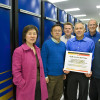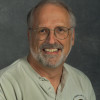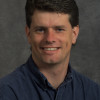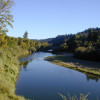News Center
LBNL Team Wins Special ACM Gordon Bell Prize for Algorithm Innovation
AUSTIN, Texas--A team of scientists from Lawrence Berkeley National Laboratory (LBNL) won a prestigious ACM Gordon Bell Prize for special achievement in high performance computing for their for research into the energy harnessing potential of nanostructures. Their method achieved impressive performance and scalability. The prize, presented in a special category for algorithm innovation, was announced Thursday, Nov. 20, at the awards session of the SC08 conference in Austin. The researchers… Read More »
ATLAS Software Team Pushes Ahead Led by CRD's David Quarrie
GENEVA, Switzerland – When the ATLAS detector goes on line in 2007 as one of two experiments on CERN´s Large Hadron Collider, pairs of protons will be hurtling around the 27-kilometer accelerator ring and smashing into each other at a rate of about one billion collisions per second. This will translate into about 40 terabytes of data, only a small portion of which will be of interest to the team of 1,800 scientists working on the project. Still, the project envisions the need to store and… Read More »
Berkeley Lab Technology for Speeding up Searches of Large Databases Wins R&D 100 Award
BERKELEY, Calif.—An indexing technology developed by researchers at Lawrence Berkeley National Laboratory which allows users to search massive datasets up to 40 times faster has been recognized with a 2008 R&D 100 award. The award, presented by R&D Magazine, “provides a mark of excellence known to industry, government, and academia as proof that the product is one of the most innovative ideas of the year.” The awards will be presented at a special ceremony in Chicago in October. Read More »
Research on Code Optimization Explores Multicore Computing, Wins Best Paper Award
A research paper exploring ways to make a popular scientific analysis code run smoothly on different types of multicore computers won a Best Paper Award at the 2008 IEEE International Parallel and Distributed Processing Symposium (IPDPS) this month. The paper’s lead author and CRD researcher, Samuel Williams, and his collaborators chose the lattice Bolzmann code to explore a broader issue: how to make best use of multicore supercomputers. The multicore trend started recently, and the… Read More »
CRD's Michael Wehner Contributes to National Report on Impacts of Climate Change on Transportation
WASHINGTON, D.C. – According to a report issued this week by the National Research Council, every mode of transportation in the U.S. will be affected as the climate changes, with the greatest impact expected to result from flooding of roads, railways, transit systems, and airport runways in coastal areas because of rising sea levels and surges brought on by more intense storms. Though the impacts of climate change will vary by region, it is certain they will be widespread and costly in human… Read More »
Berkeley Lab’s Vern Paxson Honored for Research Characterizing the Internet
Vern Paxson, a network researcher at the U.S. Department of Energy’s Lawrence Berkeley National Laboratory, has been awarded the Association for Computing Machinery’s Grace Murray Hopper Award for his work in measuring and characterizing the Internet. “His innovative techniques are used to assess new communications concepts, improve network performance, and prevent network intrusion,” according to the ACM. “ They provide both the research community and Internet operators with the… Read More »
LBNL Mathematician James Sethian Elected to National Academy of Engineering
James Sethian, head of the Mathematics Group at the U.S. Department of Energy’s Lawrence Berkeley National Laboratory and a professor of mathematics at the University of California at Berkeley, has been elected to the National Academy of Engineering. Sethian was one of 65 new members and nine foreign associates whose election was announced Friday, Feb. 8. Sethian was honored “for the development of efficient methods of tracking moving interfaces.” Sethian’s research has led to the… Read More »
December 2007 Staff Research Notes
Nano Poster Wins AwardThree researchers from won the Best Poster Award at the November SC07 supercomputing conference in Reno. Zhengji Zhao, Juan Meza and Lin-Wang Wang were recognized for their poster describing "A New O(N) Method for Petascale Nanoscience Simulations,” which describes new linear scaling three-dimensional fragment (LS3DF) method for ab initio electronic structure calculations. The poster was one of 39 accepted for the conference from more than 150 submissions. SC07 is the… Read More »
Science Journal Features Research On Petascale Enabling Technologies
The November 2007 issue of the Cyberinfrastructure Technology Watch (CTWatch) Quarterly included significant contributions – five out of the nine articles – from CRD researchers, who authored papers on code performance, software tools, visualization, scientific data management and data placement solutions for distributed petascale science. The issue featured articles written by dozens of researchers about SciDAC’s Centers for Enabling Technologies. SciDAC (Scientific Discovery through… Read More »
Deconstructing Microbes
A metagenome data management and analysis system developed and managed by CRD researchers contributed to a breakthrough research recently published in Nature that probed the genetic materials of microbes in a termite’s gut. Understanding how these microbes convert wood to energy for sustaining a termite’s life would help researchers figure out better ways to convert biomass to biofuels in factories. The microbes exude enzymes that efficiently break down the wood’s cellular structure, but… Read More »
Lab Authors' Paper in Nano Letters Draws Strong Interest
A research paper showing how zinc oxide can be manipulated to become a good material for photovoltaic devices was among the most-accessed paper published by Nano Letters in the third quarter. The paper, written by Joshua Schrier, Denis Demchenko and Lin-Wang Wang in CRD’s Scientific Computing Group, laid out the calculations that narrowed the band gap – the energy difference between the top of the valence band and the bottom of the conduction band – of zinc oxide. To effectively absorb… Read More »
Algorithm Solves Key Energy-reduction Issue in Describing Complex System
The SIAM Journal on Scientific Computing recently published the work by three CRD researchers that incorporated an algorithm they developed in computing the ground state energy and wave functions for describing the mechanics of a complex physical system. The paper, “A Trust Region Direct Constrained Minimization Algorithm for the Kohn-Sham Equation,” described the use of the direct constrained minimization (DCM) algorithm with the “trust region” technique to compute single electron… Read More »
June 2007 Staff Research Notes
New Money, New AlgorithmsXiaoye “Sherry” Li has been awarded $10,000 from the France-Berkeley Fund, which aims to stimulate research exchanges among scientists from the University of California and France. Li, who is a researcher in CRD’s Scientific Computing Group, and her project co-leader from France, plan to use the money to further their work on developing novel algorithms for solving large sparse linear systems, used in many time-consuming computations in fields such as fluid… Read More »
CCSE's Marc Day Awarded NASA Allocation for Combustion Research
Research to quantify the formation of pollutants during natural gas combustion has received 1.5 million computing hours from NASA. Led by Marc Day in CRD’s Center for Computational Sciences and Engineering, the project, “Flames Dynamics and Emission Chemistry in High-Pressure Industrial Burners,” was one of the four awarded by NASA last month under its National Leadership Computing System initiative. The initiative sets out to support computationally intensive projects that advance a… Read More »
Nanowire’s Novel Properties Could Increase Power Output In Solar Cells
A CRD scientist has designed a nanowire with potential of generating electricity more efficiently than many conventional materials currently used for solar cells. Using gallium nitride and gallium phosphide, Lin-Wang Wang and two collaborators at the National Renewable Energy Laboratory in Colorado have modeled the nanowire—a coaxial cable—that overcomes several key problems encountered in bulk material solar cells and hydrogen fuel production today. “Bulk materials have lots of… Read More »
Serving Up a Smoother Flow of Water Resources Data
A collaboration among Microsoft, Berkeley Lab and UC Berkeley is underway to develop a scientific data server for amassing and organizing water data from diverse sources, a system that will accelerate research in the increasingly important areas of water and climate change. Called Microsoft e-Science, the project is part of the Berkeley Water Center’s effort to marshal expertise from public institutions and the private sector and support projects that enable researchers to easily access and… Read More »
Supercomputing Report Card
A comprehensive supercomputer performance evaluation undertaken by CRD scientists has won a Best Paper award in the Application track at the IEEE International Parallel and Distributed Processing Symposium (IPDPS), underscoring the significant contribution the research makes to improving scientific applications for the arrival of petascale computing. The paper, “Scientific Application Performance on Candidate PetaScale Platforms,” is an accumulation of four years of exhaustive study that… Read More »
CRD Staff Have Strong Presence at SIAM Conference
This year’s SIAM Conference on Computational Science and Engineering (CSE) featured a strong showing from CRD scientists, who spent a week in Costa Mesa, California this month to discuss topics that ranged from nanoscience simulations to scientific data management. SIAM is the Society for Industrial and Applied Mathematics. In all, 13 researchers from the division attended the week-long conference, which also ran concurrently with the SIAM Workshop on Combinatorial Scientific Computing. Read More »
February 2007 Staff Research Notes
Paxson Named ACM FellowVern Paxson, a researcher in CRD’s Distributed Systems Department, has been named a fellow of the Association for Computing Machinery (ACM). The fellowship is given to scientists who have made “outstanding technical and professional achievements in the field of information technology,” according to ACM. Paxson is probably best known for his original development work on Bro, the Lab’s intrusion detection system, which monitors incoming and outgoing traffic and… Read More »
CRD Takes Lead at DOE Cybersecurity Workshop
CRD scientists co-chaired and led discussions in a DOE Office of Science workshop last month that defined the research and development goals for cybersecurity in the global scientific community. The three-day workshop, sponsored by the Office of Advanced Scientific Computing Research and titled, “DOE Cybersecurity R&D Challenges for Open Science,” pooled knowledge and experiences from about 40 cybersecurity production personnel and cybersecurity researchers from across the DOE Office of… Read More »
BDMTC, JGI Announce IMG/M Upgrade
The DOE Joint Genome Institute (JGI), collaborating with CRD’s Biological Data Management and Technology Center (BDMTC), announced last month an upgrade of the metagenome data management and analysis system, IMG/M, on the anniversary of its launch. Developed by BDMTC’s data management and software engineers and scientists of JGI’s Genome Biology and Microbial Ecology Programs, IMG/M is a valuable asset for a growing community of biologists. Metagenomics refers to the genomic study of… Read More »
Q&A with NERSC Director Horst Simon
Horst Simon, who has been director of DOE’s National Energy Research Scientific Computing Center (NERSC) since early 1996, announced last month that he was stepping down in order to focus his energy on the two other positions he holds at Lawrence Berkeley National Laboratory. Once a new director for NERSC is hired, Simon will concentrate on his duties as Associate Laboratory Director for Computing Sciences and Computational Research Division (CRD) Director. With the search for a new NERSC… Read More »
Andy Aspden Joins CCSE as Inaugural Seaborg Post-Doc Fellow
Armed with a Ph.D in applied mathematics from the University of Cambridge and a thirst to “broaden his horizon,” Andy Aspden has joined Berkeley Lab as part of the inaugural class for the Glenn T. Seaborg Postdoctoral Fellowships. Aspden will work with John Bell, leader of the Center for Computational Sciences and Engineering in CRD, to expand on his research in fluid dynamics. Aspden, who began his appointment last month, met Bell three and a half years ago when Bell was collaborating… Read More »
CRD Scientists Contribute To A Definitive Book On Parallel Processing
Demand for improving powerful computers has been growing as more researchers worldwide rely on these systems to solve complex scientific problems—fast. In a new book co-edited by LBNL’s Associate Laboratory Director for Computing Sciences, Horst Simon, scientific computing experts from universities and national labs provide a comprehensive look at the state of the art in scientific computing for the effective use of highly parallel computers. The book, titled “Parallel Processing for… Read More »
Paxson's Internet Research Earns "Test of Time" Award
Working in the fast-paced field of Internet research, Vern Paxson of CRD’s Distributed Systems Department has won the inaugural Test of Time Award from the Special Interest Group on Data Communications (SIGCOMM) of the Association for Computing Machinery (ACM). The new award, announced in the current issue of Computer Communication Review (CCR), recognizes research from 10 to 12 years ago that marked a milestone in its field and continues to provide insight today. SIGCOMM recognized Paxson… Read More »






















